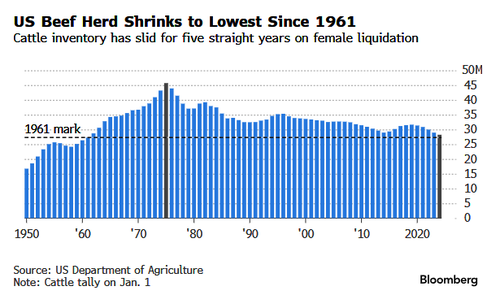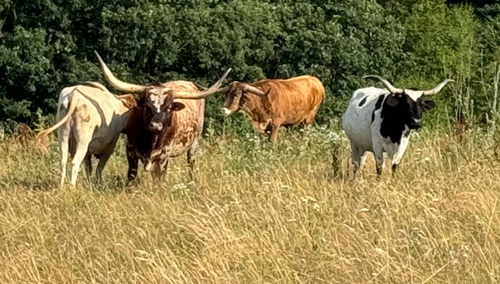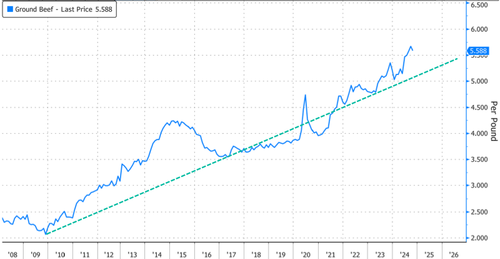America's beef cow inventory has steadily declined over the last half-decade, reaching 64-year lows and signaling a deepening crisis across the cattle industry. As the cattle crisis worsens, consumers should brace for higher ground beef prices.
The shrinking beef supply has pushed the nation's herd size to its smallest level since 1961. With severe droughts, high interest rates, costly feed prices, sliding farm income, surging farm debt, and a shifting consumer preference toward cheaper chicken, struggling ranchers have been culling heifers, preventing any meaningful recovery in the number of calves necessary to expand the nation's herds.
As Bloomberg reports, the nation's cattle crisis is set to worsen with new pressures: first, President-elect Trump's anticipated tariff war 2.0, which is expected to tighten domestic beef supplies, and second, immigration reform.
"All of the things he is talking about have potentially negative consequences more so than anything positive," Derrell Peel, a professor of agricultural economics at Oklahoma State University, told Bloomberg, adding, "Our fate's pretty well determined in the cattle industry in the U.S. for the next two to four years" – and it's not looking good."
In February, the United States Department of Agriculture projected that the cattle herd could begin rebuilding by 2025. However, that timeline has since shifted to 2027. The reason is primarily because of high interest rates and poor pasture conditions in the Midwest.
"Even as the beef industry has experienced periods of growth over the past decades, the animal count has dropped almost 40% since a peak in 1975. During the current downcycle, which started in 2020, the herd has been shrinking at the fastest pace since the big farm crisis of the 1980s," Bloomberg noted.
If Trump introduces new tariffs, it could disrupt the flow of imported beef, further tightening domestic supplies. However, as Bill Bullard, CEO of R-CALF USA—a group representing cow-calf producers nationwide—explained, this move will drive up beef prices while encouraging investment in rebuilding the nation's cattle herd.
Bullard said, "Tariffs will provide our industry an opportunity to invest in expansion and to begin rebuilding the herd that has been shrinking at an alarming rate," adding, "Over the long term, consumers are going to be better served because we will no longer have such a dependency on imported products."
America's beef supply relies heavily on small producers raising calves, but with herd levels at half-century lows—combined with new factors like tariffs and immigration reform that could drive prices even higher—consumers need to recognize that food inflation will likely remain sticky through the decade's end.
Earlier this year, Tyson Foods CEO Donnie King told the BMO Global Farm to Market Conference that he wasn't even sure when the nation's collapsing herd size would reverse.


